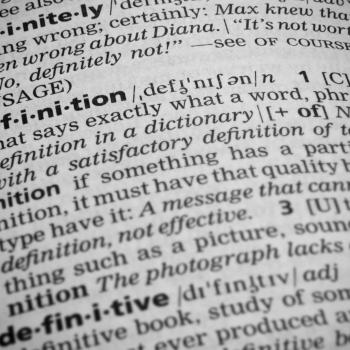Using a Word Journal to Create a Personal Dictionary

- Preview |
- Standards |
- Resources & Preparation |
- Instructional Plan |
- Related Resources |
- Comments
Overview
Learning new vocabulary words is important for all readers, and an important part of the learning process is finding the definitions. This lesson teaches students how to track unfamiliar words as they read, link these words to their background knowledge, create new sentences for their words, and finally develop a project that displays their new vocabulary. This lesson could be adapted for ELL students or students in grades 3 to 5.
From Theory to Practice
- Vocabulary instruction, whether it is focused on narrative or informational text, is most effective when it relates new words or derivations of words to existing vocabulary and background knowledge.
- Active processing, which associates experiences and concepts with words, contributes significantly to vocabulary growth, comprehension, and continuous learning.
Common Core Standards
This resource has been aligned to the Common Core State Standards for states in which they have been adopted. If a state does not appear in the drop-down, CCSS alignments are forthcoming.
State Standards
This lesson has been aligned to standards in the following states. If a state does not appear in the drop-down, standard alignments are not currently available for that state.
NCTE/IRA National Standards for the English Language Arts
- 3. Students apply a wide range of strategies to comprehend, interpret, evaluate, and appreciate texts. They draw on their prior experience, their interactions with other readers and writers, their knowledge of word meaning and of other texts, their word identification strategies, and their understanding of textual features (e.g., sound-letter correspondence, sentence structure, context, graphics).
Materials and Technology
- Access to a computer with the Internet and PowerPoint
- Overhead projector
- Pens or pencils
- Single-subject notebook
Printouts
Websites
Preparation
Begin this lesson with a class discussion of how your students typically learn new words. Are there any "tricks" that they use to learn new words while reading a story? Introduce them to a new way of learning vocabulary by organizing unfamiliar words in a word journal to create a personal dictionary. All students should have a notebook for their word journal. A single-subject notebook works best for this activity, but students may use whatever kind of notebook they have available. Students will need a working knowledge of PowerPoint to complete the final project.
Student Objectives
Students will
- Record words they are unfamiliar with in a word journal notebook
- Determine the meaning of words through context, dictionary use, or class discussion
- Create a PowerPoint presentation that explains a select number of words from their journal
Instruction & Activities
| 1. | To help students understand the purpose of a word journal, present the class with a list of words from an upcoming book or chapter. The list should include both familiar and unfamiliar words. Give students time to try and define as many words as they can on their own using their prior knowledge. Then gather students in groups to compare their definitions and explain to one another how they knew certain words. The purpose of this activity is to demonstrate that each student knows different words and has a need to learn different words; thus, a personal word journal is useful. |
| 2. | To help students understand the elements of a word journal entry, distribute the word journal handout as a sample. Each page in their notebook should be dedicated to a single word. Students can discuss other things that they would like to include within the journal entry and determine what would help them learn and remember new words. A "concept wheel" is often helpful for learning new words and should be taught to students and considered as an element of the journal entry. |
| 3. | To model how the word journal can be used, read a few sentences aloud from a text. Act like a student, and verbalize your thoughts when encountering an unfamiliar word. Begin creating a word journal entry on an overhead. Write the word at the top of the page and verbally walk through each step. Use the context of the sentence to determine the word's meaning. Verbalize any background knowledge you have relating to that word (e.g., it sounds like... I wonder if it means...). Use a dictionary to record the word's actual definition, and then write a new sentence using the word. Show students how to complete the rest of the journal entry as illustrated on the word journal handout. |
| 4. | The word journal can be used in two ways. To introduce words to the entire class, students can be given a list of words from an upcoming story (with sentences). As they read the story, they add any unfamiliar words to the list. Another option is to allow students to make their own list of unfamiliar words as they read a story. Because students may need to know the meaning of a word while reading, they can be directed to make a partial journal entry to determine the meaning of the word and then complete the rest of the entry at another time. Students should be encouraged to keep a small piece of paper inside their book to write down unfamiliar words while they read. This will prevent them from ignoring words or jumping to a dictionary right away. |
| 5. | The final project requires students to choose about 15 words from their word journal (depending on the number of words learned and the time available) and create a PowerPoint presentation. As a general overview, give each student a PowerPoint instruction sheet. For those students who struggle with PowerPoint, one-on-one assistance is recommended. Each slide should have one word, its definition, and a sentence using that word correctly. Students may also include clip art related to the word depending on their expertise with PowerPoint and the availability of appropriate clip art. |
Extensions
- This lesson can easily be extended as a dictionary lesson in which students get more detailed information about dictionary entries.
- This lesson can be extended to teach students about synonyms, antonyms, and analogies.
Student Assessment / Reflections
The main assessment is the daily word journal entries, which can be checked and graded at any time. Students are expected to have at least 27–30 words in their journals after a nine-week period. The final PowerPoint presentation can also be used as an assessment. Students are expected to select 15 words that they will use in a future writing project. Each slide is worth five points (one for the slide itself, one for content, one for the definition, and one for the sentence).

Add new comment